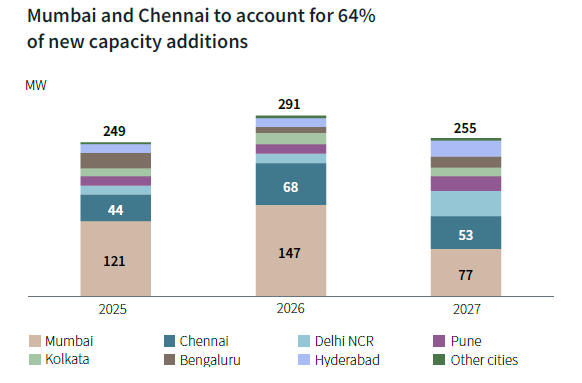India’s data center capacity could go up to 1.8 GW by the end of 2027 as per the findings of a report by Jones Lang LaSalle (JLL), a renowned global commercial real estate and investment management company. The report titled India Data Center Market Dynamics also found that India’s data center capacity surged past the 1 GW mark at the end of 2024, and stood at around 1030 MW (live IT load) of which 993 MW was occupied.
According to the report, there was a sharp 51 percent year-on-year rise in demand in H2 2024 of about 122 MW, which was met with supply. Mumbai accounted for nearly half the supply during this period. By the end of 2027, there will be a capacity addition of 795 MW, with Mumbai and Chennai accounting for 64 percent of new capacity additions.
Mumbai’s data center market experienced significant transformation in H2 2024, driven by the migration of BFSI players to colocation facilities, found the report. It further cited the Maharashtra government’s amended data center policy, offering incentives for green integrated data centers, as a significant catalyst for investment. Moreover, hyperscalers were securing large land parcels near power sources.
Meanwhile, Chennai’s data center market has seen significant supply growth in anticipation of pre-commitments from hyperscale Cloud Service Providers (CSPs). Major players have adopted land banking strategy for building hyperscale data centers. Moreover, there’s a growing trend of GPU adoption for AI workloads in the Chennai market.

Delhi NCR witnessed 26.1 MW absorption primarily due to deliveries to cloud service providers. Demand from domestic cloud players is expected to gain traction. India AI mission and policy incentives are expected to lay the foundation for future enterprise demand. Meanwhile, in Bengaluru, no capacity addition was witnessed during H2 2024 as players used existing facilities to meet demand. Demand growth has also been marginal in H2 2024 with 500KW from a technology player. The report found that various R&D labs of technology players are exploring colocation options while deciding their expansion plans, and demand from domestic technology players to offer cloud services is expected to pick up.
Among relatively smaller markets, CSP led commitments have been leading demand growth during H2 2024 in Pune. CSPs are outsourcing construction to colocation operators with ability to construct and deliver core and shell facilities. Meanwhile, AI-based startups and technology firms are expected to drive new demand.
In Hyderabad, self-build facilities by CSPs are scaling up operations, however adequate power availability and skilled manpower could pose challenges to growth. Cloud service providers are exploring self build options for AI-related deployments which are less latency sensitive.
The market is expected to pick up pace in Kolkata after the West Bengal state government announced that undersea cable landing station will be operational in Digha in Purba Medinipur district in the first quarter of 2026. More capacities are expected to go live in anticipation of demand from CSPs and BFSI segments.




